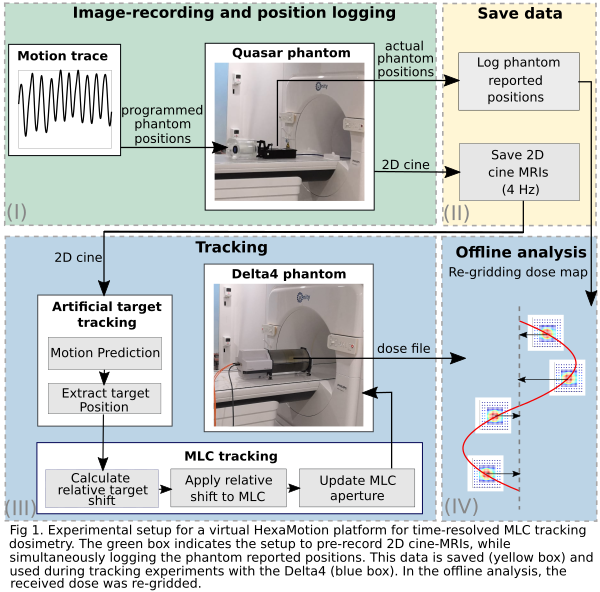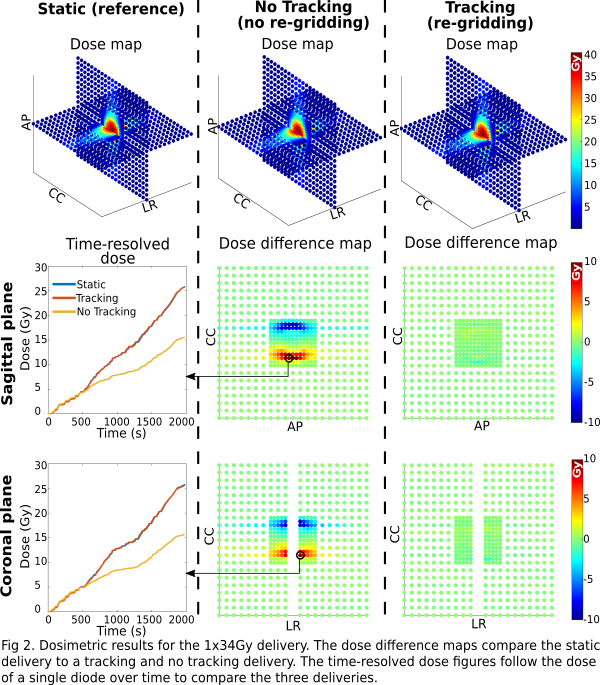A virtual HexaMotion platform for the MR-linac: time-resolved MLC tracking dosimetry
Prescilla Uijtewaal,
The Netherlands
PO-1524
Abstract
A virtual HexaMotion platform for the MR-linac: time-resolved MLC tracking dosimetry
Authors: Prescilla Uijtewaal1, Pim Borman1, Peter Woodhead1,2, Wilfred de Vries1, Peter Münger3, Görgen Nilsson3, Sara Hackett1, Joost Verhoeff1, Bas Raaymakers1, Martin Fast1
1University Medical Center Utrecht, Department of Radiotherapy, Utrecht, The Netherlands; 2Elekta, AB, Stockholm, Sweden; 3ScandiDos, AB, Uppsala, Sweden
Show Affiliations
Hide Affiliations
Purpose or Objective
To maximize healthy tissue
sparing in the presence of intra-fractional motion, we previously developed
MRI-guided MLC tracking for the 1.5T Unity MR-linac (Elekta AB, Stockholm, SE).
Dosimetric analyses were performed using film dosimetry which lacks temporal
and through-plane spatial resolution. To expand the dosimetric analysis of MLC
tracking from 2D to time-resolved 3D, and to eliminate film-related dosimetric
uncertainty, the Delta4+ MR phantom (ScandiDos AB, Uppsala, SE) is a viable
alternative. However, the Delta4 cannot move and its electronics do not allow
for real-time MR-imaging. In this study, we introduce a virtual
HexaMotion platform for the Delta4 to quantify the dosimetric
benefits of MRI-guided MLC tracking.
Material and Methods
All
experiments were performed on an MR-linac in research mode. For the Delta4 we
used research software provided by ScandiDos enabling VMAT support and time-resolved
data export/input.
Because the
Delta4 cannot move, we initially used the Quasar MRI4D phantom
(ModusQA, London, ON) for image recording and programmed it with
patient-derived respiratory CC motion (A=11mm, T=3s, drift=0.6mm/min). We
pre-recorded the phantom motion using 2D-cine MRI at 4Hz, and simultaneously logged
the phantom reported (ground-truth) positions. Next, to perform tracking with
the Delta4, we streamed the recorded Quasar images to the tracking software to
mimic a delivery to a moving target.
The Delta4
was positioned centrally or peripherally (10cm off-centre) in the bore. The
phantom contains two orthogonal planes (sagittal/coronal) filled with diode
arrays to measure dose every 25ms. The central 6x6cm2 of diodes are
spaced 5mm apart, with 10mm spacing elsewhere. Because the Delta4 records the
received dose every 25ms, and the logged target position is known within each dose
interval, we can deduce how far off-centre the dose was delivered. To
artificially move the phantom with the target, we shifted the measured
incremental dose by the same amount but in opposite direction as the target had
moved w.r.t the iso-centre. Dose shifts
were carried out by re-gridding the data using cubic spline interpolation.
We created
three VMAT treatment plans for lung SBRT with 3mm GTV-to-PTV margins: a central plan
(8x7.5Gy) and two peripheral plans (3x18Gy and 1x34Gy). A 1%/1mm local Gamma-analysis
quantified dose differences between a static delivery and tracking cases.

Results
The 1x34Gy dose
maps (Fig 2) show the effect of a virtual HexaMotion platform. W/o tracking (no
re-grid) differences with the static delivery are up to 10Gy, while this reduces
to <1.5Gy with tracking. Following a single diode over time shows
superimposed dose lines for static and tracking, while w/o tracking it receives
only 60% of the dose.
Gamma
pass-rates improved from 74.0% to 98.4% (8x7.5Gy), 34.7% to 98.1% (3x18Gy) and 17.8% to 99.7% (1x34Gy).

Conclusion
We created
a virtual HexaMotion platform to quantify the time-resolved performance
of MRI-guided MLC-tracking in 3D using a Delta4 on Unity.